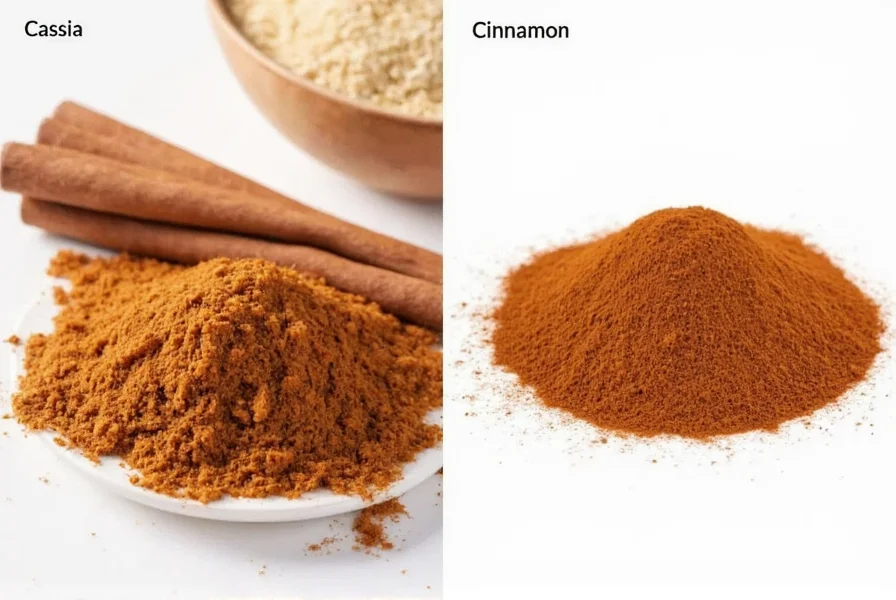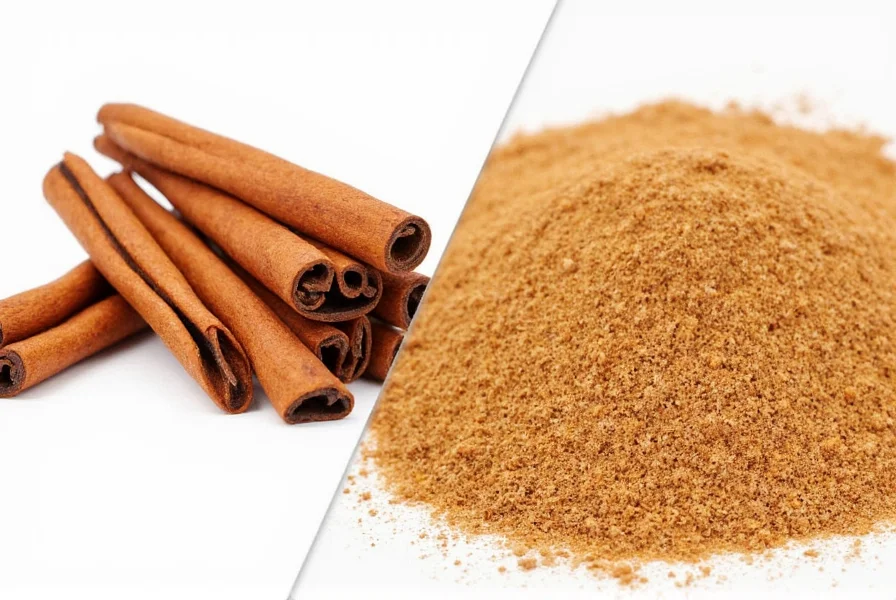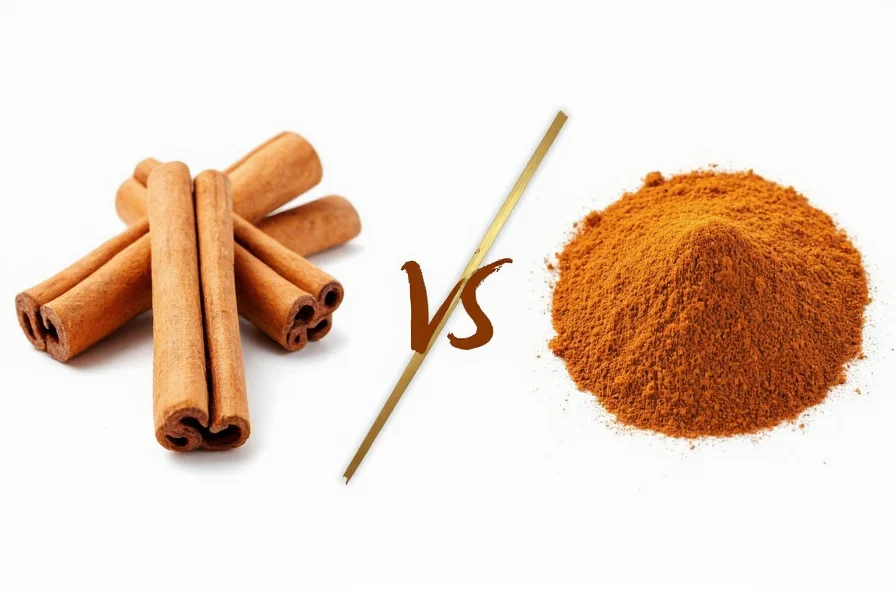Cassia and cinnamon are often confused, but they're distinct spices. True cinnamon (Ceylon cinnamon) comes from Cinnamomum verum trees, primarily grown in Sri Lanka, with a delicate, sweet flavor and multiple thin bark layers. Cassia, commonly sold as “cinnamon” in the US, comes from Cinnamomum cassia trees, mainly from China and Indonesia, featuring a stronger, spicier taste and a single thick bark layer. The most critical difference is coumarin content—cassia contains up to 1% coumarin (potentially harmful in large quantities), while Ceylon cinnamon has only trace amounts (0.004%).
When you reach for that spice jar labeled “cinnamon,” you might actually be using cassia without realizing it. This common confusion affects millions of consumers worldwide, especially in North America where cassia dominates supermarket shelves. Understanding the distinction between these two spices isn't just academic—it has real implications for your health and culinary results.
Botanical Origins and Global Production
True cinnamon, scientifically known as Cinnamomum verum (formerly Cinnamomum zeylanicum), originates from Sri Lanka, where it's been cultivated for centuries. This “Ceylon cinnamon” represents only about 10-15% of the global cinnamon market. In contrast, cassia comes primarily from Cinnamomum cassia trees grown in China, Indonesia, and Vietnam, accounting for 85-90% of cinnamon sold worldwide.
The production process differs significantly. Ceylon cinnamon harvesters carefully peel multiple thin layers of inner bark, which naturally curl into delicate, multi-layered “quills” or sticks. Cassia producers remove a single thick bark layer that forms a dense, hard stick with a rough exterior. These structural differences make visual identification possible even for non-experts.

Physical Characteristics Comparison
| Characteristic | Ceylon Cinnamon (True Cinnamon) | Cassia Cinnamon |
|---|---|---|
| Bark Structure | Multiple thin, papery layers | Single thick, hard layer |
| Color | Light tan to medium brown | Dark reddish-brown |
| Texture | Soft, crumbly when broken | Hard, difficult to break |
| Rolling Method | Natural curling during drying | Forced rolling into tubes |
| Inner Surface | Smooth with fine lines | Rough with visible pores |
Flavor Profiles and Culinary Applications
The taste difference between these spices explains why professional chefs carefully select between them. Ceylon cinnamon offers a subtle, sweet, citrusy flavor with delicate floral notes—ideal for dishes where cinnamon should complement rather than dominate. It shines in French pastries, Middle Eastern rice dishes, and delicate desserts like crème brûlée.
Cassia delivers a powerful, spicy-hot punch with intense warmth that stands up to bold flavors. This makes it perfect for cinnamon rolls, chai tea, and hearty baked goods where its robust character won't get lost. Many commercial cinnamon products use cassia precisely because its stronger flavor survives industrial processing better than delicate Ceylon cinnamon.
Health Implications: The Coumarin Factor
The most significant health consideration involves coumarin, a naturally occurring compound. Cassia contains substantially higher levels (up to 1% by weight) compared to Ceylon cinnamon (trace amounts around 0.004%). While coumarin has blood-thinning properties, excessive consumption can cause liver damage in sensitive individuals.
According to European Food Safety Authority guidelines, the acceptable daily intake of coumarin is 0.1 mg per kilogram of body weight. For a 60 kg (132 lb) person, this equals 6 mg daily. Just one teaspoon (2.6g) of cassia cinnamon contains approximately 5.8-12.1 mg of coumarin—potentially exceeding safe limits with regular consumption. Ceylon cinnamon users can enjoy larger quantities without coumarin concerns.

Shopping Guide: How to Identify Authentic Cinnamon
Most US grocery stores sell cassia but label it simply as “cinnamon.” To find true Ceylon cinnamon:
- Check packaging for “Ceylon cinnamon” or Cinnamomum verum
- Look for “True Cinnamon” labeling (increasingly common)
- Examine the sticks—Ceylon forms delicate, multi-layered tubes
- Consider specialty spice retailers or Latin American markets (where Ceylon is more common)
- Price point—authentic Ceylon typically costs 2-3 times more than cassia
When purchasing ground cinnamon, identification becomes trickier. Some premium brands specify the type, but most don't. If coumarin content is a concern, consider switching to Ceylon specifically for daily consumption in items like oatmeal or smoothies, while reserving cassia for occasional baking projects.
Storage Recommendations for Maximum Freshness
Both spices benefit from proper storage, but their different structures affect longevity. Ceylon cinnamon's delicate layers make it more vulnerable to moisture and air exposure. Store both in airtight containers away from light and heat, but expect Ceylon to maintain peak flavor for 6-12 months versus cassia's 1-2 years.
Grind Ceylon cinnamon sticks just before use for optimal flavor—its volatile oils dissipate faster than cassia's more robust compounds. For cassia, pre-ground works acceptably well due to its stronger chemical composition.
Practical Usage Recommendations
Understanding when to use each spice elevates your cooking:
- Choose Ceylon cinnamon for: Delicate desserts, custards, fruit compotes, breakfast cereals, and daily health-focused applications
- Choose cassia for: Bold baked goods, mulled wines, spice blends like garam masala, and recipes where cinnamon should dominate
- For health-conscious consumers: Use Ceylon for daily consumption, especially if taking cinnamon supplements
- For baking substitutions: Use 1:1 ratio, but reduce cassia by 25% when replacing Ceylon due to stronger flavor
Conclusion: Making Informed Spice Choices
The cassia versus cinnamon distinction matters more than most consumers realize. While both spices share similar aromatic compounds, their structural, flavor, and health profile differences make them suited for different applications. By understanding these differences—particularly the coumarin content in cassia—you can make informed choices that enhance both your culinary creations and long-term wellness. The next time you reach for that “cinnamon” jar, take a moment to consider whether you're actually using true cinnamon or its more common cassia counterpart.
Frequently Asked Questions
Is cassia cinnamon dangerous to consume?
Cassia cinnamon isn't dangerous when consumed in typical culinary amounts. The concern involves coumarin content—a compound that can cause liver issues with excessive, long-term consumption. For most adults, consuming up to 1 teaspoon of cassia daily remains within safe limits. Those with liver conditions or taking blood thinners should consult their physician and consider switching to Ceylon cinnamon for regular use.
How can I tell if my ground cinnamon is Ceylon or cassia?
Identifying ground cinnamon types is challenging without lab testing. Check packaging for “Ceylon” or “true cinnamon” labeling. Ceylon typically has a lighter tan color and finer texture. You can also assess flavor—Ceylon is sweeter and more delicate, while cassia is stronger and spicier. For certainty, purchase from specialty spice retailers who specify the cinnamon type, or buy whole sticks which are easier to distinguish visually.
Which type of cinnamon is better for managing blood sugar?
Both cinnamon types show potential blood sugar benefits, but research hasn't conclusively determined which is superior. The active compounds responsible for potential glucose regulation—cinnamaldehyde and polyphenols—exist in both varieties. For regular consumption aimed at blood sugar management, Ceylon cinnamon is generally recommended because you can safely consume larger quantities without coumarin concerns, potentially increasing effectiveness.
Why does the United States primarily sell cassia instead of true cinnamon?
Several factors contribute to cassia's dominance in the US market: it's significantly cheaper to produce (growing faster and yielding more per tree), has a stronger flavor that survives industrial processing better, and has been traditionally used in American baking recipes. Historical trade patterns established cassia as the standard, and most American consumers have grown accustomed to its bolder flavor profile in classic recipes like cinnamon rolls and apple pie.
Can I substitute Ceylon cinnamon for cassia in recipes?
Yes, but with adjustments. Ceylon cinnamon has a more delicate flavor, so you may need to use 25-50% more to achieve similar intensity. In recipes where cinnamon plays a supporting role (like baked goods with multiple spices), a 1:1 substitution usually works well. For dishes where cinnamon is the star flavor (like cinnamon toast or snickerdoodle cookies), increase the Ceylon amount slightly. When substituting cassia for Ceylon, reduce the amount by 25% to avoid overpowering other flavors.











 浙公网安备
33010002000092号
浙公网安备
33010002000092号 浙B2-20120091-4
浙B2-20120091-4